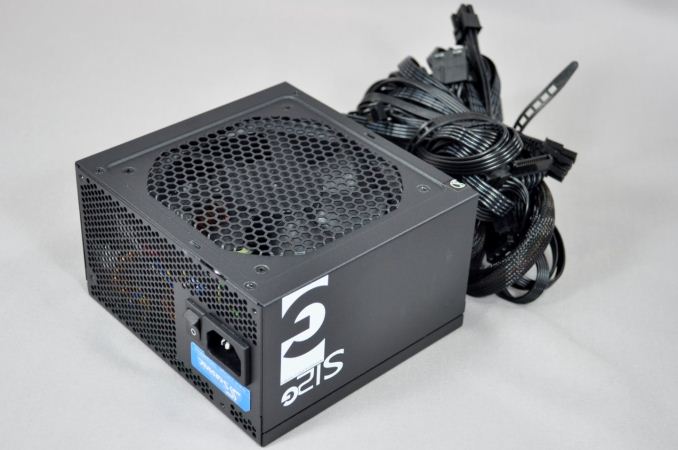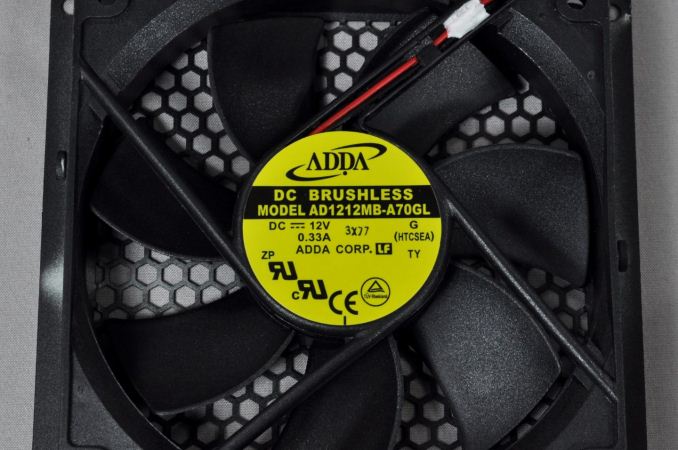Seasonic S12G 650W Power Supply Review
by E. Fylladitakis on February 28, 2014 2:20 PM EST- Posted in
- Cases/Cooling/PSUs
- Seasonic
- 80 Plus Gold
External Appearance
The Seasonic S12G sports a small, typical ATX-sized (140mm) chassis that has been sprayed with a matte black paint. Some effort has been made to improve the appearance of the power supply, albeit not all of the measures can be considered successful. Seasonic uses all-black ribbon cables, with the exception of the 24-pin ATX cable that uses typical color-coded wires and sleeving. A blue sticker has been placed on the rear of the unit, where it will be visible from the back of a case once the PSU has been installed. Oddly enough however, the company sprayed the series logo in white on the right side of the chassis, where it will be facing the right side panel of a case. It goes without saying that it will not be visible inside the vast majority of the cases currently in the market. On the other hand, the sticker with the specifications of the PSU has been placed on the left side of the chassis. No effort has been made at all to enhance the top side of the chassis visually, so in a bottom-mounted location users with case windows will simply see a black surface.
Internal Design
We were surprised the instant that we opened up the chassis of the S12G 650W unit. The unit is cooled by an ADDA AD1212MB-A70GL fan, unlike the majority of Seasonic's other models that use SanAce fans. The particular fan model is high quality, featuring a "Hypro" liquid bearing and with a maximum speed of 2050 RPM, yet it is no SanAce. When you have to compete in the mainstream market and even a few dollars can make an immense difference on sales, you have to keep the retail price as low as possible, which is most probably why Seasonic went with the ADDA fan for the S12G. Note also that as this unit has no fanless mode, it does not require a fan with extraordinary specifications (e.g. a very low starting voltage).
It is obvious that the OEM behind the S12G is Seasonic, as the company designs, manufactures, and markets their own units. We spot four heatsinks; the smallest one handles the rectifier bridge, the one near the edge of the PCB cools the active PFC components, and those on each side of the main transformer handle the inversion and conversion transistors of the primary and secondary stage respectively. The input filter begins on the PCB attached to the back of the receptacle, but continues on the main PCB until the input of the rectifier bridge. We spot a total of six Y capacitors, two X capacitors, and two filtering inductors, which form an excellent intake filter.
In terms of component and build quality, Seasonic does not let us down. The primary capacitor and most of the smaller capacitors are supplied by Nippon Chemi-Con, with some Rubycon electrolytic capacitors after the secondary side heatsink as well. Everything is well shielded and secured with glue, ensuring the mechanical cohesion of the unit. The inductors are glued and also tightened with cable ties, in order to minimize the chance of vibration-generated noise (also known as "coil whine"). The quality of the soldering is very good, well above what we would consider average. There are a few spots where excessive solder has been applied, but that hardly is worth commenting on in a $90 MSRP PSU.






















77 Comments
View All Comments
platos - Saturday, March 1, 2014 - link
I also want to see low wattage small form factor PSUs like the picoPSU and compatible bricks. I'm personally moving away from large desktops for my DIY PCs. I'm even hoping for pico and nano-ITX boards and cases to become popular.I'm guessing large desktops will mostly be confined to companies in the near future and they are more likely to buy PSUs as part of a complete system so they wouldn't directly care about individual PSU ratings.
E.Fyll - Saturday, March 1, 2014 - link
" My homeserver is pulling 35W from the wall right at this moment. "If you are not using a true RMS meter to read this figure, I am afraid that your actual power draw is way off. Especially with the PSU that you are using.
Daniel Egger - Sunday, March 2, 2014 - link
Actually that's what my APC UPS tells me which is also continuously read out so I also know the load profile over time and can even correlate with the temperature.Not too much of a fan reconnecting 24/7 servers too often from the mains just put different power reading hardware in between I must say.
From what I can tell the readings from the UPS is quite accurate: I've tested it with a variety of computer and other IT equipment using switching PSUs with a true RMS meter in between.
E.Fyll - Sunday, March 2, 2014 - link
The UPS has no true RMS reading, sorry...emn13 - Saturday, March 1, 2014 - link
It's the GPU's that are costing you. I've got a standard voltage, overclocked 4770k which is currently fully loaded and it's using 97W at the wall outlet; it idles at 20W - that's including power supply overhead. With some undervolting rather than overclocking I can get that down to 15W, with 1HDD and 3SSDs, but my motherboard isn't very friendly to undervolting so I decided it wasn't worth the bother.A single GPU, even if it's not the top of the line, can easily consume more than the entire rest of your system. You say you have two GPU's? Well, there you go: 20W for the base system, 20W for each GPU and you're in about the right ballpark.
mike55 - Friday, February 28, 2014 - link
Excellent article! I would definitely be interested in seeing an article about how to choose the right PSU. There is a lot of information out there, but a lot of it seems to suggest PSUs that can provide a lot more power than what I think should be necessary, resulting in less than optimal power conversion efficiency. It would be nice to see some more objective information. Although, I suppose there is some value in getting something over sized for future proofing. Especially for a quality PSU at less than $100.Egg - Friday, February 28, 2014 - link
IIRC the Seasonic X650 used to be this price with a modular interface. Well, I guess since the quality is just as good, and possibly even more efficient, we can hope for sales.tynopik - Friday, February 28, 2014 - link
where's the description of the cable?There used to be a chart breaking down each cable and the lengths to each connector:
http://www.anandtech.com/show/6168/rosewill-fortre...
also, isn't a shot of the wattage chart de rigeur?
extide - Saturday, March 1, 2014 - link
x2 these should be includedPcgeek21 - Friday, February 28, 2014 - link
I agree with Daniel; I would be very interested in the performance/efficiency of low wattage power supplies (200W-300W peak output). I run relatively low power servers at home 24/7 such that the 5W delta in power draw can add up over the 4-5 year lifetime of the equipment.I purchased an Antec EarthWatts EA-450 (http://www.eteknix.com/antec-earthwatts-platinum-4... several months ago for my current server. I would be very interested in determining if it was a worthwhile investment or if there are any better alternatives available on the market.
I look forward to more PSU reviews.